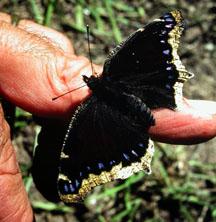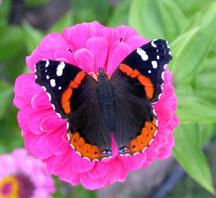Butterflies and a Declaration of Interdependence
- Share
- Tweet
- Pin
- Share
It has been said that butterflies are the only “bugs” that people aren’t afraid of. They can’t bite or sting, and they won’t chase after you. They go wherever they please, and they please wherever they go. The fact that these insects (no, they are not bugs!) are primarily day-fliers, especially on sun-drenched days, and are attracted to colorful flowerbeds should make flower gardening doubly pleasant. As far as I can determine, they have no damaging or harmful effect on the environment, as some moths do, such as the Gypsy Moth. If a living creature could serve as a role model in some respects for people, my choice would be the butterfly.
A good friend of mine since my boyhood in Kewaunee was Sylvester “Suddy” Ziemer, who ran a small neighborhood grocery store and, through his own learning and dedication, became one of our state’s top butterfly experts. Upon his death, his large butterfly collection, representing over 60 years of studying the butterflies of the Kewaunee area, was donated to the Invertebrate Zoology department at the Milwaukee Public Museum. It was Suddy who sparked my interest in admiring, studying, photographing and writing about these incredible little creatures.
July has always been the most butterfly-rich month of the year during the 46 years I’ve been in Door County. It shouldn’t come as a surprise that their numbers can fluctuate considerably from year to year depending upon various factors such as availability of host plants for the larvae, severity of the winter in regarding those species which overwinter as adults, over-use of pesticides to which butterflies are extremely intolerant, and even the past several rather severe summer droughts in our region.
Many people, including Charlotte and me, had earlier sightings of a fair number of Monarchs than in most years. We’ve seen very few since the last week of May, the most likely reason being that once their eggs are laid on one of the species of milkweeds it won’t be long and those adults will die, and it will take three to four weeks before the next generation of adults will have eclosed (emerged from the chrysalis) and will be seen. I check the large leafed-out Swamp Milkweed plant in our butterfly “way station” daily, a raised-bed garden in the front yard, and so far have seen at least six or more Monarch larvae.
A fair number of Mourning Cloaks, very dark brown to black butterflies with a narrow cream-colored border on the leading edge of the front wings, appeared early this spring having over-wintered as adults. Hardly a week goes by without our seeing a few. Two other over-wintering species seen at our place have been the Painted Lady and the Milbert’s Tortoiseshell. Several Catnip plants grow in our front yard. The tubular blue flowers are very attractive to the hummingbirds and the leaves serve as one of the host plants for the Painted Lady. People tend to cringe when we tell them that we maintain a patch of Stinging Nettles (a native plant) near our garden shed, simply because they are one of the few host plants of the beautiful and very early-appearing Milbert’s Tortoiseshell.
Recently several White Admirals have appeared along our driveway, much to my enjoyment. This dark blue-black, three to three-and-a-half inch butterfly, with bold white bands running through both front and rear wings, ranks high on my list of favorites. Fortunately many Paper Birches, Quaking Aspens and Black and Choke Cherry trees grow in our woods, their favorite host plants. Also beginning to appear quite regularly are the Little Wood Satyr and the Pearl Crescent, usually two of the most abundant July butterflies.
Butterflies are closely dependent on their well-defined ecosystems, and it deeply saddens me to see so many ecosystems deteriorate at the hands of people. Finally, years later with just tiny fragments of the original plants, animals, and insects still intact, biologists try vainly – and all too often unsuccessfully – to bring back the beauty of the natural plants and animals.
Knowing what is occurring rampantly around the world, such as the tragic oil spill in the Gulf of Mexico, you’d think the logical direction to be taking NOW is to learn what our immediate environments are like, precisely what they contain, the elements and balances required to maintain the various healthy viable environments – and keep them that way. Unfortunately, money speaks much louder than do butterflies – and the people who like them.
Having written so many stories about and stood up in defense of the small “creatures without words” over the past 42 years, I can’t help but be concerned over the rapidly diminishing environments required by many species of butterflies.
I would like to propose the following Declaration of Interdependence to which I was introduced in the past, via a newsletter from the Forest Park Nature Center at Peoria, IL. It reads as follows:
“When in the course of Earthly events a single creature so dominates the planet that by their whims, tens of thousands of other living things face extinction or endangerment, it becomes necessary to affirm forthrightly that all the Earth’s inhabitants, large and small, are part of the same living tapestry. Furthermore that every strand of that tapestry is vitally important to the welfare of every other strand.
“We the undersigned joyfully acknowledge partnership with our fellow residents of planet Earth and resolve to do our part to make our planet a more habitable place for all living things.”
How the butterflies would joyously flap their wings if every man, woman and child were to sign this Declaration of Interdependence and carry it out to perfection! Long live the butterflies and their all-important ecosystems!



